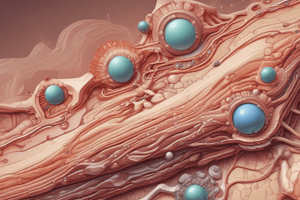Podcast
Questions and Answers
What is the main function of collagen in the dermis?
What is the main function of collagen in the dermis?
- Supporting fibroblasts
- Providing strength and elasticity to the skin (correct)
- Synthesizing ground substance
- Creating a moisture-retaining environment
What is the main function of the blood vessels in the dermis?
What is the main function of the blood vessels in the dermis?
- To provide structural support to the skin
- To transmit sensory information to the brain
- To supply nutrients and oxygen to the skin (correct)
- To synthesize new collagen and elastic fibers
Which protein is the most abundant in the human body?
Which protein is the most abundant in the human body?
- Keratin
- Collagen (correct)
- Fibronectin
- Elastin
What is the main role of fibroblasts in the dermis?
What is the main role of fibroblasts in the dermis?
How does the dermis contribute to thermoregulation in the body?
How does the dermis contribute to thermoregulation in the body?
What is the function of elastic fibers in the skin?
What is the function of elastic fibers in the skin?
What happens to the dermis as a person ages?
What happens to the dermis as a person ages?
Which component fills the spaces between collagen fibers in the dermis?
Which component fills the spaces between collagen fibers in the dermis?
Which component of the dermis is responsible for helping maintain the skin's hydration levels?
Which component of the dermis is responsible for helping maintain the skin's hydration levels?
Why is the dense collagen and elastic fiber network important in the dermis?
Why is the dense collagen and elastic fiber network important in the dermis?
Which layer of the skin is sandwiched between the epidermis and subcutaneous tissue?
Which layer of the skin is sandwiched between the epidermis and subcutaneous tissue?
How does understanding the changes in the dermis with age help promote healthier skin?
How does understanding the changes in the dermis with age help promote healthier skin?
Flashcards are hidden until you start studying
Study Notes
Exploring the Dermis: A Peek Beneath the Surface of Human Skin
The skin, our most visible organ, provides a protective barrier that shields us from the outside world. Yet, beyond the epidermis, which forms the outermost layer, lies a more complex and vital region called the dermis. This middle layer of the skin plays a crucial role in our overall health and well-being, and understanding its structure and functions can give us insights into the intricacies of human anatomy.
Structure and Composition
The dermis, comprised mostly of collagen and elastic fibers, is sandwiched between the epidermis and the subcutaneous tissue (hypodermis). It's a matrix of interconnected fibrous proteins, supporting cells, and other components that provide structural integrity, moisture retention, and elasticity to our skin.
- Collagen and Elastic fibers: These fibers create a lattice-like structure, providing strength and elasticity to the skin. Collagen, the most abundant protein in the human body, is responsible for about 75% of the dry weight of the skin. Elastic fibers, on the other hand, give the skin its ability to stretch and return to its original shape.
- Ground substance: A gel-like substance that fills the spaces between collagen fibers, providing a moisture-retaining environment for the skin.
- Fibroblasts: These cells synthesize collagen and elastic fibers and maintain the ground substance in the dermis.
- Blood vessels and nerves: The dermis houses an extensive network of blood vessels and nerves that supply nutrients and oxygen to the skin and transmit sensory information to the brain.
Function and Importance
The dermis plays an integral role in maintaining the skin's health, appearance, and function:
- Mechanical support: The dense collagen and elastic fiber network provides structural support to the skin, preventing it from sagging or losing its shape.
- Moisture retention: The ground substance and other components in the dermis help to maintain the skin's hydration levels.
- Thermoregulation: The dermis plays a role in moderating the body's temperature through the regulation of blood flow to the skin.
- Sensory perception: Nerve endings in the dermis transmit tactile information to the brain, enabling us to perceive touch, temperature, and pressure.
- Wound healing: The dermis is involved in the repair and regeneration of damaged skin, as fibroblasts synthesize new collagen and elastic fibers to replace damaged tissue.
Dermis and Aging
As we age, the dermis loses some of its structural integrity and elasticity. This results in wrinkling, sagging, and a loss of skin tone. The decrease in collagen and elastic fibers, combined with the breakdown of ground substance, causes the skin to lose its ability to maintain moisture and regenerate itself efficiently.
Conclusion
The dermis, a vital component of human skin, offers a supportive environment that enables the skin to function as a protective barrier, maintain hydration levels, and transmit sensory information. By understanding the structure and function of the dermis, we can appreciate its importance in maintaining our overall health and well-being.
As we age, the dermis undergoes structural changes, leading to a loss of skin tone and elasticity. By understanding the changes that occur in the dermis as we age, we can find ways to promote healthier skin and combat the effects of aging. With further research and a deeper understanding of the dermis, we can continue to make strides in the field of skin health and wellness.
Studying That Suits You
Use AI to generate personalized quizzes and flashcards to suit your learning preferences.




